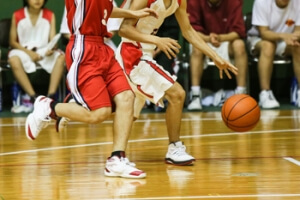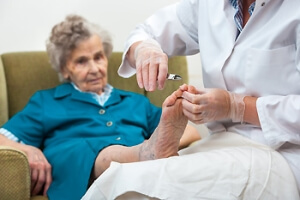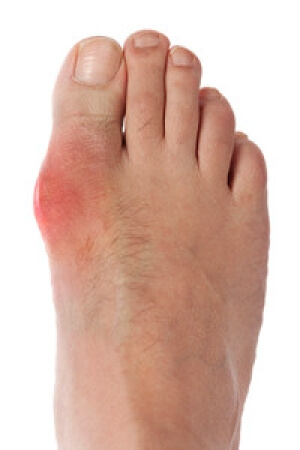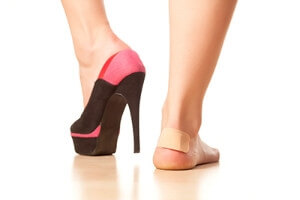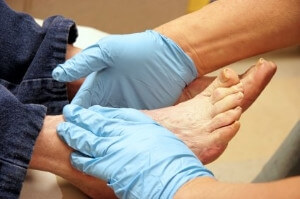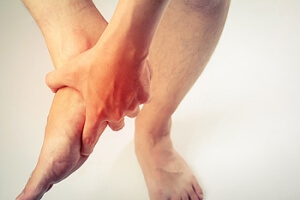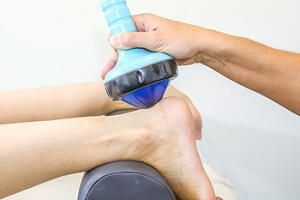Super User
DeMarcus Cousins Injures Achilles Tendon
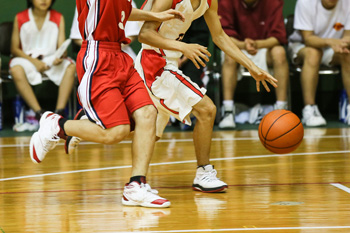 Demarcus Cousins of the New Orleans Pelicans recently ruptured his Achilles Tendon during a Friday night game. With just 15 seconds remaining, Cousins went to rebound on a free throw he missed and landed on his left leg. Now, Cousins must miss the remainder of the season from having to undergo surgery. Cousins will be immobilized for quite some time and have to go through physical therapy to regain strength and range of motion in his ankle and leg. It is said that the rate of recovery from surgery associated with this injury are high. With professional athletes having a different standard of physical health, this injury may hinder their athletic performance in the future. That being said, many people are curious to see how well Cousins will perform when he returns.
Demarcus Cousins of the New Orleans Pelicans recently ruptured his Achilles Tendon during a Friday night game. With just 15 seconds remaining, Cousins went to rebound on a free throw he missed and landed on his left leg. Now, Cousins must miss the remainder of the season from having to undergo surgery. Cousins will be immobilized for quite some time and have to go through physical therapy to regain strength and range of motion in his ankle and leg. It is said that the rate of recovery from surgery associated with this injury are high. With professional athletes having a different standard of physical health, this injury may hinder their athletic performance in the future. That being said, many people are curious to see how well Cousins will perform when he returns.
Achilles tendon injuries need immediate attention to avoid future complications. If you have any concerns, contact one of our podiatrists of New Tampa Foot & Ankle. Our doctors can provide the care you need to keep you pain-free and on your feet.
What Is the Achilles Tendon?
The Achilles tendon is a tendon that connects the lower leg muscles and calf to the heel of the foot. It is the strongest tendon in the human body and is essential for making movement possible. Because this tendon is such an integral part of the body, any injuries to it can create immense difficulties and should immediately be presented to a doctor.
What Are the Symptoms of an Achilles Tendon Injury?
There are various types of injuries that can affect the Achilles tendon. The two most common injuries are Achilles tendinitis and ruptures of the tendon.
Achilles Tendinitis Symptoms
- Inflammation
- Dull to severe pain
- Increased blood flow to the tendon
- Thickening of the tendon
Rupture Symptoms
- Extreme pain and swelling in the foot
- Total immobility
Treatment and Prevention
Achilles tendon injuries are diagnosed by a thorough physical evaluation, which can include an MRI. Treatment involves rest, physical therapy, and in some cases, surgery. However, various preventative measures can be taken to avoid these injuries, such as:
- Thorough stretching of the tendon before and after exercise
- Strengthening exercises like calf raises, squats, leg curls, leg extensions, leg raises, lunges, and leg presses
If you have any questions please feel free to contact our office located in Wesley Chapel, FL . We offer the newest diagnostic tools and technology to treat your foot and ankle needs.
How Elderly Folks Can Maintain Proper Foot Conditions
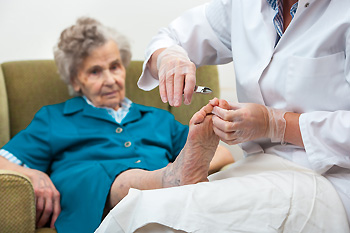 As we age, the skin on our feet becomes thinner, potentially leading to foot infections, corns, and blisters. Difficulty in bending down and having poor eyesight can make it frustrating to trim the toenails. Caring for the feet may become easier when a regular foot routine is implemented. This may include cutting the toenails straight across, making sure the feet are clean and dry, and wearing shoes and socks that fit properly. The best time of day to shop for shoes is in the afternoon when the feet are at their biggest, so the fit will be comfortable all day. Typically, using a good moisturizer will not only feel good, but will be beneficial in helping to heal dry, cracked skin. It’s crucial to notice signs of infection, especially if diabetes is present, in addition to treating any form of toenail fungus that may exist. A consultation with a podiatrist may be suggested if foot pain and discomfort is experienced.
As we age, the skin on our feet becomes thinner, potentially leading to foot infections, corns, and blisters. Difficulty in bending down and having poor eyesight can make it frustrating to trim the toenails. Caring for the feet may become easier when a regular foot routine is implemented. This may include cutting the toenails straight across, making sure the feet are clean and dry, and wearing shoes and socks that fit properly. The best time of day to shop for shoes is in the afternoon when the feet are at their biggest, so the fit will be comfortable all day. Typically, using a good moisturizer will not only feel good, but will be beneficial in helping to heal dry, cracked skin. It’s crucial to notice signs of infection, especially if diabetes is present, in addition to treating any form of toenail fungus that may exist. A consultation with a podiatrist may be suggested if foot pain and discomfort is experienced.
Everyday foot care is very important to prevent infection and other foot ailments. If you need your feet checked, contact one of our podiatrists from New Tampa Foot & Ankle. Our doctors can provide the care you need to keep you pain-free and on your feet.
Everyday Foot Care
Often, people take care of their bodies, face and hair more so than they do for their feet. But the feet are a very important aspect of our bodies, and one that we should pay more attention to. Without our feet, we would not be able to perform most daily tasks.
It is best to check your feet regularly to make sure there are no new bruises or cuts that you may not have noticed before. For dry feet, moisturizer can easily be a remedy and can be applied as often as necessary to the affected areas. Wearing shoes that fit well can also help you maintain good foot health, as well as making it easier to walk and do daily activities without the stress or pain of ill-fitting shoes, high heels, or even flip flops. Wearing clean socks with closed shoes is important to ensure that sweat and bacteria do not accumulate within the shoe. Clean socks help to prevent Athlete’s foot, fungi problems, bad odors, and can absorb sweat.
If you have any questions please feel free to contact our office located in Wesley Chapel, FL . We offer the newest diagnostic and treatment technologies for all your foot and ankle needs.
How Do I Know if I Have Gout?
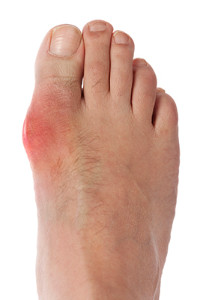 When excess uric acid is present in the blood, it may cause a painful condition referred to as gout. Gout is a form of arthritis, and the causes of it may also lead to potential problems involving the kidneys. Pain, swelling, and extreme tenderness are common symptoms associated with this condition, and they generally continue for 7-10 days. There are several possible causes of gout, two of which are a predisposed inherited trait and a diet largely consisting of excess red meat, beer, and sugar. An attack of gout must first be diagnosed, and there are several ways this can be accomplished. X-rays may be taken, in addition to performing a procedure where a small amount of fluid is removed from the joint that appears to be affected. Treatment for this condition will depend on the severity of the disorder, and a consultation with a podiatrist is advised for the best available options.
When excess uric acid is present in the blood, it may cause a painful condition referred to as gout. Gout is a form of arthritis, and the causes of it may also lead to potential problems involving the kidneys. Pain, swelling, and extreme tenderness are common symptoms associated with this condition, and they generally continue for 7-10 days. There are several possible causes of gout, two of which are a predisposed inherited trait and a diet largely consisting of excess red meat, beer, and sugar. An attack of gout must first be diagnosed, and there are several ways this can be accomplished. X-rays may be taken, in addition to performing a procedure where a small amount of fluid is removed from the joint that appears to be affected. Treatment for this condition will depend on the severity of the disorder, and a consultation with a podiatrist is advised for the best available options.
Gout is a foot condition that requires certain treatment and care. If you are seeking treatment, contact one of our podiatrists from New Tampa Foot & Ankle. Our doctors will treat your foot and ankle needs.
What Is Gout?
Gout is a type of arthritis caused by a buildup of uric acid in the bloodstream. It often develops in the foot, especially the big toe area, although it can manifest in other parts of the body as well. Gout can make walking and standing very painful and is especially common in diabetics and the obese.
People typically get gout because of a poor diet. Genetic predisposition is also a factor. The children of parents who have had gout frequently have a chance of developing it themselves.
Gout can easily be identified by redness and inflammation of the big toe and the surrounding areas of the foot. Other symptoms include extreme fatigue, joint pain, and running high fevers. Sometimes corticosteroid drugs can be prescribed to treat gout, but the best way to combat this disease is to get more exercise and eat a better diet.
If you have any questions please feel free to contact our office located in Wesley Chapel, FL . We offer the newest diagnostic and treatment technologies for all your foot and ankle needs.
To Wear or Not To Wear High Heels
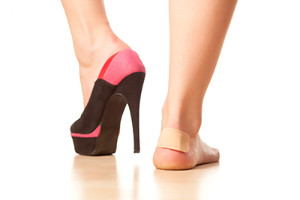 Wearing high heels may negate the fact that the feet act as shock absorbers. If proper shoes are worn, cushioning in the soles of the shoes generally protects the body from the constant battering incurred while walking and running. However, if the choice to wear high heels is made, the body’s weight shifts onto the balls of the feet, forcing the toes to be crammed into a small area and potentially resulting in all kinds of conditions. There are typically several reasons to avoid wearing high heels, one of which is abnormal movement occurring in the ankles. This can result from the foot being forced to bend forward, possibly restricting circulation in the feet. Additionally, the Achilles tendon is often affected which may cause pain in the calves. If high heels are consistently worn, the ankle and calf tendons may lose flexibility, making it difficult to walk. Good advice is to wear high heels as little as possible.
Wearing high heels may negate the fact that the feet act as shock absorbers. If proper shoes are worn, cushioning in the soles of the shoes generally protects the body from the constant battering incurred while walking and running. However, if the choice to wear high heels is made, the body’s weight shifts onto the balls of the feet, forcing the toes to be crammed into a small area and potentially resulting in all kinds of conditions. There are typically several reasons to avoid wearing high heels, one of which is abnormal movement occurring in the ankles. This can result from the foot being forced to bend forward, possibly restricting circulation in the feet. Additionally, the Achilles tendon is often affected which may cause pain in the calves. If high heels are consistently worn, the ankle and calf tendons may lose flexibility, making it difficult to walk. Good advice is to wear high heels as little as possible.
High heels have a history of causing foot and ankle problems. If you have any concerns about your feet or ankles, contact one of our podiatrists from New Tampa Foot & Ankle. Our doctors can provide the care you need to keep you pain-free and on your feet.
Effects of High Heels on the Feet
High heels are popular shoes among women because of their many styles and societal appeal. Despite this, high heels can still cause many health problems if worn too frequently.
Which Parts of My Body Will Be Affected by High Heels?
- Ankle Joints
- Achilles Tendon – May shorten and stiffen with prolonged wear
- Balls of the Feet
- Knees – Heels cause the knees to bend constantly, creating stress on them
- Back – They decrease the spine’s ability to absorb shock, which may lead to back pain. The vertebrae of the lower back may compress.
What Kinds of Foot Problems Can Develop from Wearing High Heels?
- Corns
- Calluses
- Hammertoe
- Bunions
- Morton’s Neuroma
- Plantar Fasciitis
How Can I Still Wear High Heels and Maintain Foot Health?
If you want to wear high heeled shoes, make sure that you are not wearing them every day, as this will help prevent long term physical problems. Try wearing thicker heels as opposed to stilettos to distribute weight more evenly across the feet. Always make sure you are wearing the proper shoes for the right occasion, such as sneakers for exercising. If you walk to work, try carrying your heels with you and changing into them once you arrive at work. Adding inserts to your heels can help cushion your feet and absorb shock. Full foot inserts or metatarsal pads are available.
If you have any questions please feel free to contact our office located in Wesley Chapel, FL . We offer the newest diagnostic and treatment technologies for all your foot and ankle needs.
How to Care for Feet Affected by Diabetes
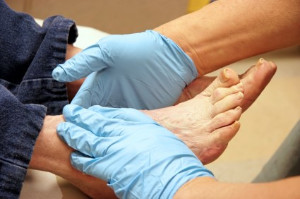 A common ailment that many diabetics have are foot problems; managing blood glucose levels, however, may help to keep the feet healthy. When nerve damage occurs in diabetics, it may cause pain and tingling, including possible numbness in the foot. Serious infections may be the result of this and can possibly lead to gangrene. It’s important to manage your diabetes; this may involve following a foot care plan. It’s crucial to check your feet daily, which will enable you to notice problems before they get worse. Some conditions to look for may be cuts, sores, or ingrown toenails. Washing your feet regularly will help you become aware of these issues. Trimming the toenails straight across the toe with clippers can help prevent the skin from being cut and can keep the toenails healthy. Consult with a podiatrist for a proper diagnosis and to learn of the treatment options available for diabetic feet.
A common ailment that many diabetics have are foot problems; managing blood glucose levels, however, may help to keep the feet healthy. When nerve damage occurs in diabetics, it may cause pain and tingling, including possible numbness in the foot. Serious infections may be the result of this and can possibly lead to gangrene. It’s important to manage your diabetes; this may involve following a foot care plan. It’s crucial to check your feet daily, which will enable you to notice problems before they get worse. Some conditions to look for may be cuts, sores, or ingrown toenails. Washing your feet regularly will help you become aware of these issues. Trimming the toenails straight across the toe with clippers can help prevent the skin from being cut and can keep the toenails healthy. Consult with a podiatrist for a proper diagnosis and to learn of the treatment options available for diabetic feet.
Diabetic foot care is important in preventing foot ailments such as ulcers. If you are suffering from diabetes or have any other concerns about your feet, contact one of our podiatrists from New Tampa Foot & Ankle. Our doctors can provide the care you need to keep you pain-free and on your feet.
Diabetic Foot Care
Diabetes affects millions of people every year. The condition can damage blood vessels in many parts of the body, especially the feet. Because of this, taking care of your feet is essential if you have diabetes, and having a podiatrist help monitor your foot health is highly recommended.
The Importance of Caring for Your Feet
- Routinely inspect your feet for bruises or sores.
- Wear socks that fit your feet comfortably.
- Wear comfortable shoes that provide adequate support.
Patients with diabetes should have their doctor monitor their blood levels, as blood sugar levels play such a huge role in diabetic care. Monitoring these levels on a regular basis is highly advised.
It is always best to inform your healthcare professional of any concerns you may have regarding your feet, especially for diabetic patients. Early treatment and routine foot examinations are keys to maintaining proper health, especially because severe complications can arise if proper treatment is not applied.
If you have any questions please feel free to contact our office located in Wesley Chapel, FL . We offer the newest diagnostic and treatment technologies for all your foot and ankle needs.
The Benefits of Foot Massages
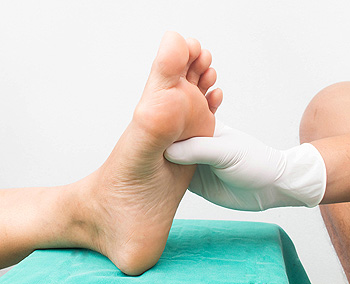 Foot massages are an effective way to transform painful, tired feet into feet that may feel brand new. It not only helps to increase blood flow, but may also help eliminate cramping or tenderness. The use of oils or lotions made for the feet are wonderful relaxation tools, in addition to helping the skin on the feet to feel soft. Massaging the toes can be done by pulling on each toe or by sliding between the toes. Using a firm circular motion with the thumbs on the foot, then using a lighter touch while moving toward the toes may be an effective way in helping to ease pain or achiness. Certain medical conditions may exist, such as gout or diabetes, and foot massages may not be recommended. Please consult with a podiatrist to see if foot massages will be beneficial to you.
Foot massages are an effective way to transform painful, tired feet into feet that may feel brand new. It not only helps to increase blood flow, but may also help eliminate cramping or tenderness. The use of oils or lotions made for the feet are wonderful relaxation tools, in addition to helping the skin on the feet to feel soft. Massaging the toes can be done by pulling on each toe or by sliding between the toes. Using a firm circular motion with the thumbs on the foot, then using a lighter touch while moving toward the toes may be an effective way in helping to ease pain or achiness. Certain medical conditions may exist, such as gout or diabetes, and foot massages may not be recommended. Please consult with a podiatrist to see if foot massages will be beneficial to you.
Foot therapy is often necessary for those recovering from either foot deformities or foot injuries. If you have concerns regarding therapy, consult with one of our podiatrists from New Tampa Foot & Ankle. Our doctors can provide the care you need to keep you pain-free and on your feet.
Most Common Injuries
People who are active or athletes are prone to a variety of injuries. Therefore, it is often important to take part in physical therapy in order to quickly get back on the right track.
What to Do When Injured
Physical Therapy – This specialized treatment will focus on the affected area, speeding up recovery and the overall healing process. It is a proven method that has helped millions of people return from any injury.
During physical therapy you will undergo regimented training to get back into full form. Training is often very difficult, especially at first when the foot feels weak. Physical therapy often involves:
Basic stretching and twisting exercises – getting the feet’s mobility and flexibility up.
Massaging – the therapist will massage the injured area in order to activate the muscles and relax them.
Strengthening Exercises – this allows the muscles in the affected area to regain their full strength, a vital step towards full recovery.
If you have any questions please feel free to contact our office located in Wesley Chapel, FL . We offer the newest diagnostic tools and technology to treat your foot and ankle needs.
Foot Therapy for Sports Injuries
Whether in practice or in the game, athletes put their bodies through great stress. Some sports demand more from the body than others. However, every sport has an element of inorganic movement or unnatural motion. For example, in softball, a pitcher winds up and flings her body with an incredible amount of dexterity in order to get the most ideal velocity out of her pitches. This motion, incredibly taxing on the body, can cause serious injury.
One of the most common issues of athletic injuries happens in the feet. If it’s a damaging fracture that leaves the athlete sidelined or just a simple turf toe, foot injuries can still be very frustrating and painful. Regardless of the sport, athletes still require use of their feet in some fashion. This is why foot therapy is extremely vital for getting athletes back on the right track to return to the field.
No matter the injury, the best way to speed up the recovery period is to receive physical therapy. Physical therapy has proven to work for millions of people. Professional physical therapists are specifically trained to help people return to proper form from any injury.
During physical therapy, you will go through organized training in order to get back into form. Sometimes training can be quite difficult, especially in the beginning when there is more pain and the foot feels awkward. To alleviate this, you will do basic twisting and stretching exercises in order to get flexibility and foot mobility back up. The therapist will also massage the injured area to activate and relax muscles. Over time you will eventually move up to strengthening exercises, designed specifically so that the injured area is exercised.
Foot therapy for sports is a modern science miracle. Unlike other treatments that may employ the use of fancy chemicals and terminology, physical therapy is an evidence-based practice that offers the same benefits. Due to huge advancements in the knowledge of muscles and joints, doctors can turn catastrophic injuries around so that athletes can return to the game once more.
Causes of Morton's Neuroma
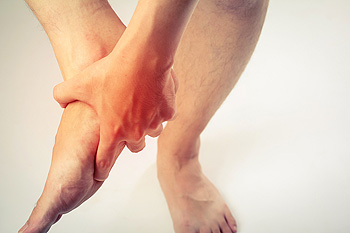 If you experience pain in between the toes or in the bottom of your feet, there's a chance that you may have Morton’s neuroma. The condition is a result of the irritation or thickening of a plantar digital nerve located between the toes. It typically starts with a tingling sensation, then may gradually worsen until it becomes a sharp, shooting pain. The foot may feel numb, and some people also experience pain while walking. Morton’s neuroma may also cause damage to the nerves in the foot. Causes include wearing ill-fitting shoes and athletic activities, like running. Both of these put pressure on the foot which can lead to Morton’s neuroma. Flare-ups can be frequent and may occur over a period of weeks before going away again. Treatment can include simple lifestyle changes such as wearing comfortable shoes and reducing high-impact activities. Only a podiatrist can provide a proper diagnosis however, so be sure to contact yours if you experience pain in the feet.
If you experience pain in between the toes or in the bottom of your feet, there's a chance that you may have Morton’s neuroma. The condition is a result of the irritation or thickening of a plantar digital nerve located between the toes. It typically starts with a tingling sensation, then may gradually worsen until it becomes a sharp, shooting pain. The foot may feel numb, and some people also experience pain while walking. Morton’s neuroma may also cause damage to the nerves in the foot. Causes include wearing ill-fitting shoes and athletic activities, like running. Both of these put pressure on the foot which can lead to Morton’s neuroma. Flare-ups can be frequent and may occur over a period of weeks before going away again. Treatment can include simple lifestyle changes such as wearing comfortable shoes and reducing high-impact activities. Only a podiatrist can provide a proper diagnosis however, so be sure to contact yours if you experience pain in the feet.
Morton’s neuroma is a very uncomfortable condition to live with. If you think you have Morton’s neuroma, contact one of our podiatrists of New Tampa Foot & Ankle. Our doctors will attend to all of your foot care needs and answer any of your related questions.
Morton’s Neuroma
Morton's neuroma is a painful foot condition that commonly affects the areas between the second and third or third and fourth toe, although other areas of the foot are also susceptible. Morton’s neuroma is caused by an inflamed nerve in the foot that is being squeezed and aggravated by surrounding bones.
What Increases the Chances of Having Morton’s Neuroma?
- Ill-fitting high heels or shoes that add pressure to the toe or foot
- Jogging, running or any sport that involves constant impact to the foot
- Flat feet, bunions, and any other foot deformities
Morton’s neuroma is a very treatable condition. Orthotics and shoe inserts can often be used to alleviate the pain on the forefront of the feet. In more severe cases, corticosteroids can also be prescribed. In order to figure out the best treatment for your neuroma, it’s recommended to seek the care of a podiatrist who can diagnose your condition and provide different treatment options.
If you have any questions, please feel free to contact our office located in Wesley Chapel, FL . We offer the newest diagnostic and treatment technologies for all your foot care needs.
Flip Flops and Feet
Flip flops are often a popular choice of footwear for many people. Flip flops allow your feet to breathe and give your toes the freedom of movement. They are easy to slip on and can be worn with virtually any style of clothing. Flip flops, however, despite their many benefits, can be detrimental for your foot health.
Despite their comfortableness, frequently wearing flip flops can create problems in the lower body over time. Issues mainly stem from the fact that people walk differently in flip flops compared to other footwear, such as sneakers. This is due to a change in one’s natural gait, which therefore creates stress in different parts of the body while hindering the body’s natural posture. Problems can also arise in the arches and balls of the feet. Flip flops provide little to no support to these areas.
Aside from long-term problems, flip-fops can also create short-term issues as well, such as ankle sprains and blisters. Weak materials that are flexible and bendable are generally used to manufacture flip flops. These materials make its wearers prone to both tripping and injuring their ankles. Flip flops can create blisters as the material rubs against the foot. People are much more at risk for infection while wearing flip flops due to their openness. This also makes it easier to scrape and cut the foot since there is a lack of protection. If these cuts are left untreated and uncovered, the risk then becomes greater.
To prevent the aforementioned occurrences, purchase a pair of flip flops that offer significant protection. The soles of the flip flops should not be floppy, but sturdy and firm, and should not significantly bend or wiggle when lifted from the floor. Flip flops made of high-quality materials will not be affected by this problem. While higher quality flip flops may be more expensive, they will last longer and provide better protection compared to a cheaper pair. Brand name flip flops sold from a quality manufacturer are a dependable option.
There is no problem in wearing your favorite pair of flip flops so as long as you do not wear them daily or for extended periods of time. Flip flops should be replaced every 3-4 months to ensure that they provide your feet with the best protection.
Shockwave Therapy Explained
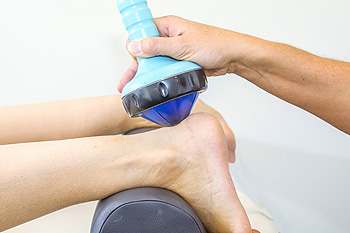 A noninvasive option for chronic heel pain is known as ESWT, or Extracorporeal Shock Wave Therapy. This treatment involves shock waves, which originate from outside of the body, and are directed onto the heel of the foot. These are sound waves, and are intended to accelerate the body’s own healing process. It has been associated with helping to heal the pain that comes from plantar fasciitis. During the relatively short procedure, the patient reclines and waves are sent to the heel of the foot. Typically, ESWT is suggested when the patient has suffered for long periods of time from chronic heel pain. This treatment has been FDA approved since 2000 and is highly effective for the treatment of pain. Consult a podiatrist to see if this procedure might be right for you.
A noninvasive option for chronic heel pain is known as ESWT, or Extracorporeal Shock Wave Therapy. This treatment involves shock waves, which originate from outside of the body, and are directed onto the heel of the foot. These are sound waves, and are intended to accelerate the body’s own healing process. It has been associated with helping to heal the pain that comes from plantar fasciitis. During the relatively short procedure, the patient reclines and waves are sent to the heel of the foot. Typically, ESWT is suggested when the patient has suffered for long periods of time from chronic heel pain. This treatment has been FDA approved since 2000 and is highly effective for the treatment of pain. Consult a podiatrist to see if this procedure might be right for you.
Shockwave therapy is a treatment commonly used to treat various injuries and conditions, particularly plantar fasciitis in the feet. To learn more, consult with one of our podiatrists from New Tampa Foot & Ankle. Our doctors can provide the care you need to keep you pain-free and on your feet.
Shockwave Therapy
Shockwave therapy is a new treatment option designed to treat bone conditions such as tennis elbow, shoulder pain, and others. Shockwave therapy uses high intensity sound waves that are directed to the affected tissues of the body with pinpoint accuracy. The effects are very beneficial, leading to a production of collagen fibers, eliminating inflammation.
Who Benefits from Shockwave?
Shockwave is recommended for patients suffering from heel pain and associated problems. Heel pain is a common condition which can be caused by obesity, overexertion, and spending a substantial amount of time on hard floors with your feet exposed and unsupported.
Fast and Easy
The therapy is actually a simple process that can leave patients feeling better the very next day. Shockwave therapy is not as dramatic as it sounds. It enables more blood flow to effected areas, addressing the source of the problem and allowing treatment to last for a long time.
Treatment & Recovery Time
Shockwave treatment will enable your feet to recover quickly. This is especially important since surgery is not required. It is cost effective and does not require the use of anesthesia. This treatment is a better option to surgery, since it is proven safe.
If you have any questions, please feel free to contact our office located in Wesley Chapel, FL . We offer the newest diagnostic and treatment technologies for all your foot and ankle needs.
